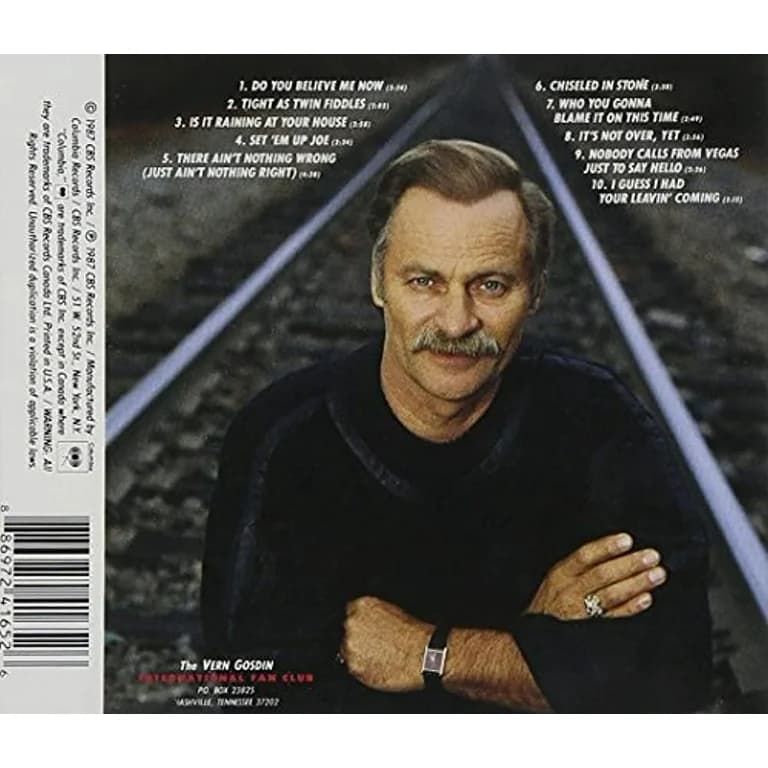
Vern Gosdin’s “It’s Not Over, Yet” – A Glimmer of Hope Amidst the Lingering Shadows of Lost Love
When one thinks of the golden age of traditional country music, particularly that rich vein of heartache and raw emotion, the name Vern Gosdin instantly comes to mind. Affectionately known as “The Voice,” he possessed a vocal delivery that could convey profound sorrow, unwavering conviction, and a lingering hope with a nuance few others could match. For those of us who appreciate the genuine article, the kind of country music that speaks directly to the soul, Gosdin was a singular talent, a true heir to the legacy of George Jones, delivering every lyric with an unvarnished sincerity that cut straight to the bone.
“It’s Not Over, Yet” is a powerful testament to Vern Gosdin’s artistry, a deeply moving track that first appeared on his critically acclaimed 1988 album, Chiseled in Stone. While the album’s title track, “Chiseled in Stone,” became a career-defining, award-winning hit for Gosdin (reaching number 6 on the Billboard Hot Country Singles & Tracks chart and securing a CMA Award for Song of the Year), “It’s Not Over, Yet” served as the B-side to another successful single from that album, “Who You Gonna Blame It On This Time,” which itself climbed to number 2 on the country charts in 1989. The album Chiseled in Stone was a commercial triumph, reaching number 7 on the Billboard Top Country Albums chart, cementing Gosdin’s status as a formidable force in country music during the late 1980s. Its success was a welcome resurgence for Gosdin, who had been a respected figure for years but truly found his commercial peak with this release.
The story woven into “It’s Not Over, Yet” is a familiar one to anyone who has grappled with the aftermath of a painful separation, yet Gosdin’s rendition infuses it with a unique blend of melancholic realism and tenacious hope. Co-written by Vern Gosdin himself and the legendary Hank Cochran, the song captures the quiet, haunting echoes of a past relationship that, for one party, simply refuses to fade. The narrative unfolds through the eyes of a man left behind, surrounded by the remnants of a shared life. We hear of the ex-lover’s pillow still on the bed, their favorite shoes in the closet, and the lingering scent of their perfume – sensory details that paint a vivid picture of absence made palpable by presence. These aren’t just objects; they are ghosts, each one a stark reminder that despite the physical separation, the emotional ties remain stubbornly intact.
The profound meaning of “It’s Not Over, Yet” lies in its exploration of the complex emotional landscape of denial and desperate hope. It’s the voice of someone who has been told it’s over, who understands the reality of the situation on an intellectual level, but whose heart simply refuses to accept it. “Something tells me, it’s not over yet,” he laments, a quiet whisper of defiance against the finality of a breakup. This isn’t a plea for reconciliation, not explicitly. Rather, it’s a raw articulation of an internal struggle, a refusal to let go of the emotional connection even when the physical one has been severed. For those of us who have walked this path, who remember the ache of a loved one’s absence made more acute by the everyday objects they left behind, this song strikes an incredibly powerful chord. It speaks to the enduring nature of love, even when it’s unrequited or seemingly lost, and the stubborn hope that can persist even in the face of overwhelming evidence. It’s a bittersweet ballad, acknowledging the pain of the present while clinging to a fragile, almost irrational, belief that the story might still have another chapter. Gosdin’s delivery, steeped in that signature blend of sorrow and resilience, ensures that “It’s Not Over, Yet” remains a timeless meditation on the echoes of love that refuse to be silenced. It’s a song that reminds us how deeply our past relationships can embed themselves in the fabric of our lives, long after the last goodbye.